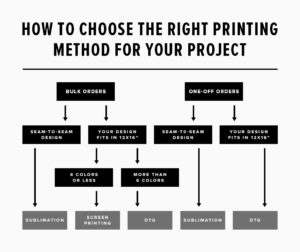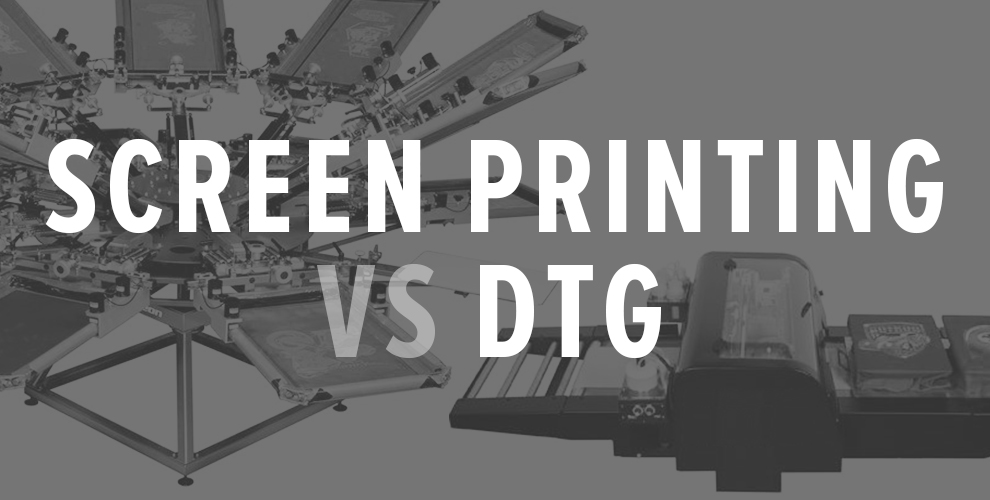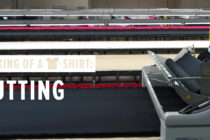Thinking about starting a T-shirt company? One of the first decisions you should make is the method you’ll use to print your apparel. And with so many options out there, the decision isn’t always easy – which is where we come in.
DTG vs. Screen Printing
Scroll down for everything you need to know about screen printing, direct-to-garment (DTG) printing, and sublimation printing so you can decide which option is the best one for you. We’ll also give you recommendations of which types of shirts work best for each method.
What is Screen Printing?
Screen printing t-shirts is one of the most popular methods of printing. When one is screen printing, they’re pulling a layer of ink over a screen to produce their desired design. A special screen is made for each design, which means that there should be a lot of orders for the specific design for it to be worth the investment. Screen printing is not only cost effective when you’re printing large batches, but it’s also versatile and less costly if you’re printing all of the same color. The cons? If you’re looking to print multiple colors, it’s not effective, and it can only print simple shape designs. Last but definitely not least, screen printing requires a large upfront investment and only allows for printing one design per batch.
Best Fabrics for Screen Printing: Another big pro for this method is that pretty much anything can be screen printed. Make sure to choose inks that work well with the type of fabric you choose. For example, stick to water based and discharge inks when printing on lightweight fabrics and triblend shirts so the garment keeps its soft hand.
What is DTG Printing?
Direct-to-garment (or DTG) printing is basically like using a printer to print directly onto fabric. DTG printing works like a printer, supporting some of the most detailed designs in the game with as many color options as you’d like. Direct to Garment printing offers up extensive color options, easily customized designs, and seriously innovative details. It is suitable for small batches and requires a minimal upfront investment. That said, DTG printing is not cost effective for larger batches, and offers up no volume discounts. Not to mention, the design placement options are very limited.
Best Fabrics for DTG: DTG works best on 100% cotton tees. Our retail jersey collection is the #1 recommended tee by DTG printers. We only use 100% combed and ring-spun cotton so it creates a very fine knit and ideal printing surface.
Sublimation
When one prints onto a special sheet of paper and then transfers that image onto fabric, it is called sublimation printing. The ink is heated until it blends into the corresponding fabric, which makes it virtually impossible to peel. Sublimation printing makes it easy for printers to print seam-to-seam, which will cover the entire garment. It works with endless color options, and really shows detail – whether you’re printing in large or small batches. The cons? Sublimation printing is not large-order friendly, and does not work on all garments.
Best Fabrics for Sublimation: For this technique you’ll need to stick to light colored garments with high polyester content. Check out our All Sport collection of poly tees. Our white marble and light colored flowy poly-viscose tees also take sublimation very well.
Ready to choose the printing method that’s best for you? We recommend first thinking of your design, then deciding how many tees you need. When you figure out the best one that works for you, be sure to head to BELLA + CANVAS for all the blanks you need to get the job done right! Happy printing!







8 Comments
Online
I know this if off topic but I’m looking into starting my own blog and was curious what all is required
to get set up? I’m assuming having a blog like yours would cost a pretty penny?
I’m not very internet savvy so I’m not 100% certain. Any suggestions or advice would
be greatly appreciated. Many thanks
BELLA+CANVAS
We suggest using the templates that companies like Word Press offer, they try to make it as seamless as possible! There are also tutorials on YouTube and other blogs to help you out!